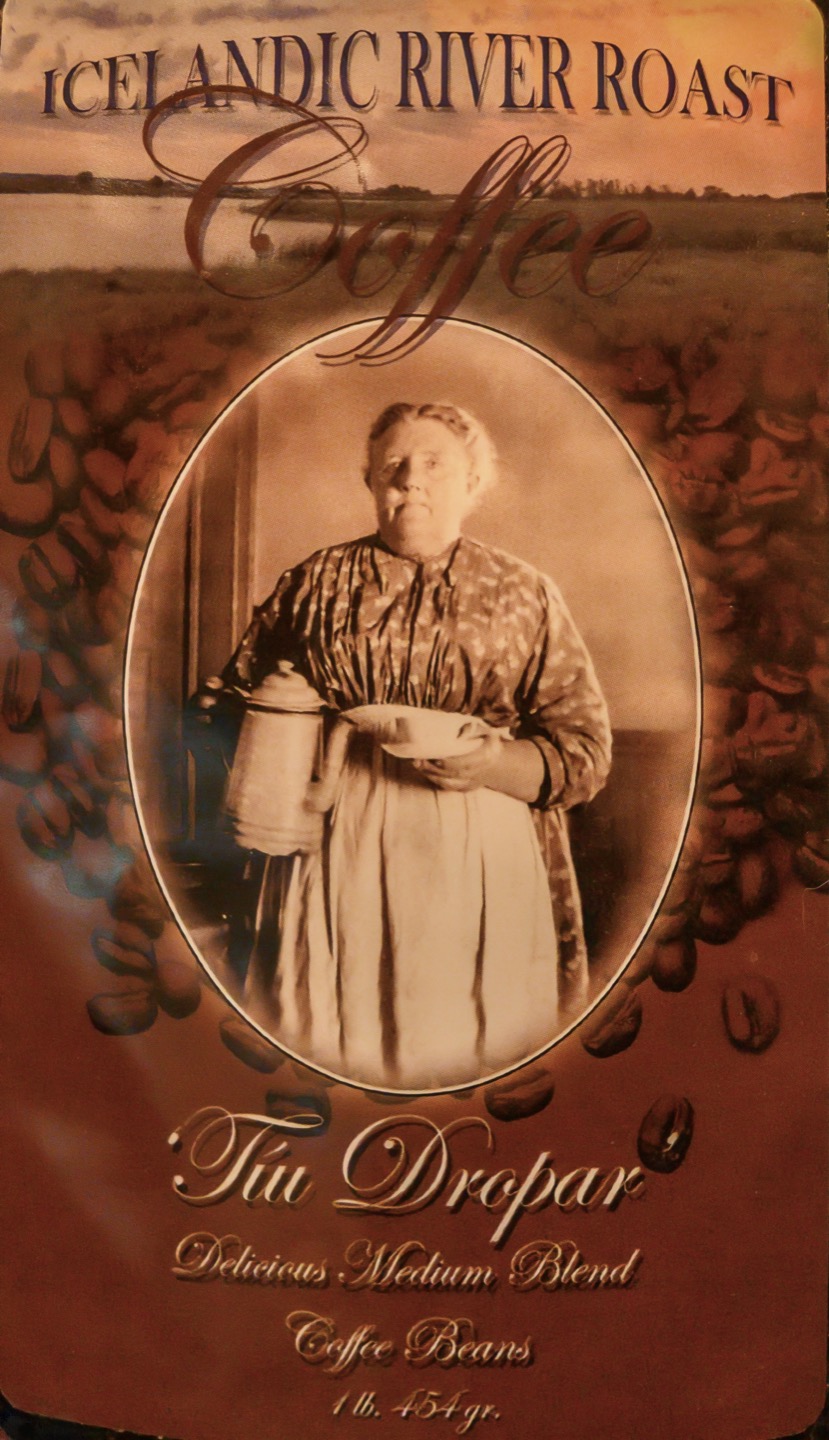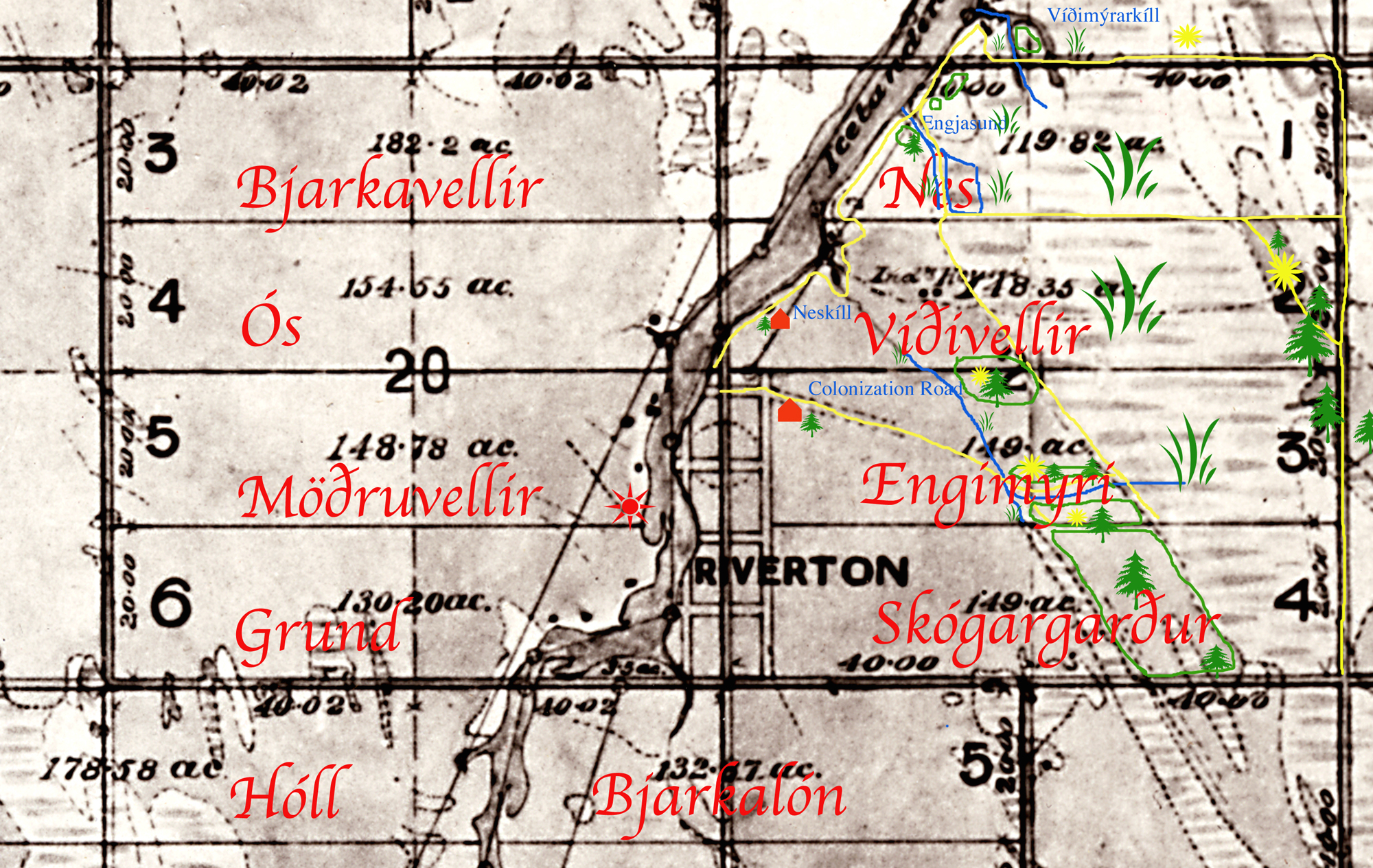- Home
- IRHS Projects
- Engimýri
Engimýri
The historic house at Engimýri (Meadow Mire), now one of the oldest surviving residences in the Icelandic River area, was built in 1900 - making it more than 110 years old. The home of pioneers Tomas Agust Jónasson and Gudrun Egidia Johannesdóttir, who arrived in New Iceland in 1876, this homestead was named for Tomas’ birthplace in the Oxnadalur Valley of Northern Iceland. As this homestead was situated at the northern terminus of the original 'Icelanders’ Road’ (Colonization Road), which connected Icelandic River with Sandy Bar, Gimli, and points further south, the home at Engimyri served as a ‘stopping place’ for travellers and a model of Icelandic hospitality - a tradition carried on from Tomas’ parents, whose home in Iceland had served as a wayside inn for many years. Subsequently occupied by son and grandson of the same name, Engimýri was designated a ‘centennial farm’ in 1977. The house is one of the few remaining structures built by pioneer carpenters Trausti Vigfusson and Jónas Jónasson of Loni.
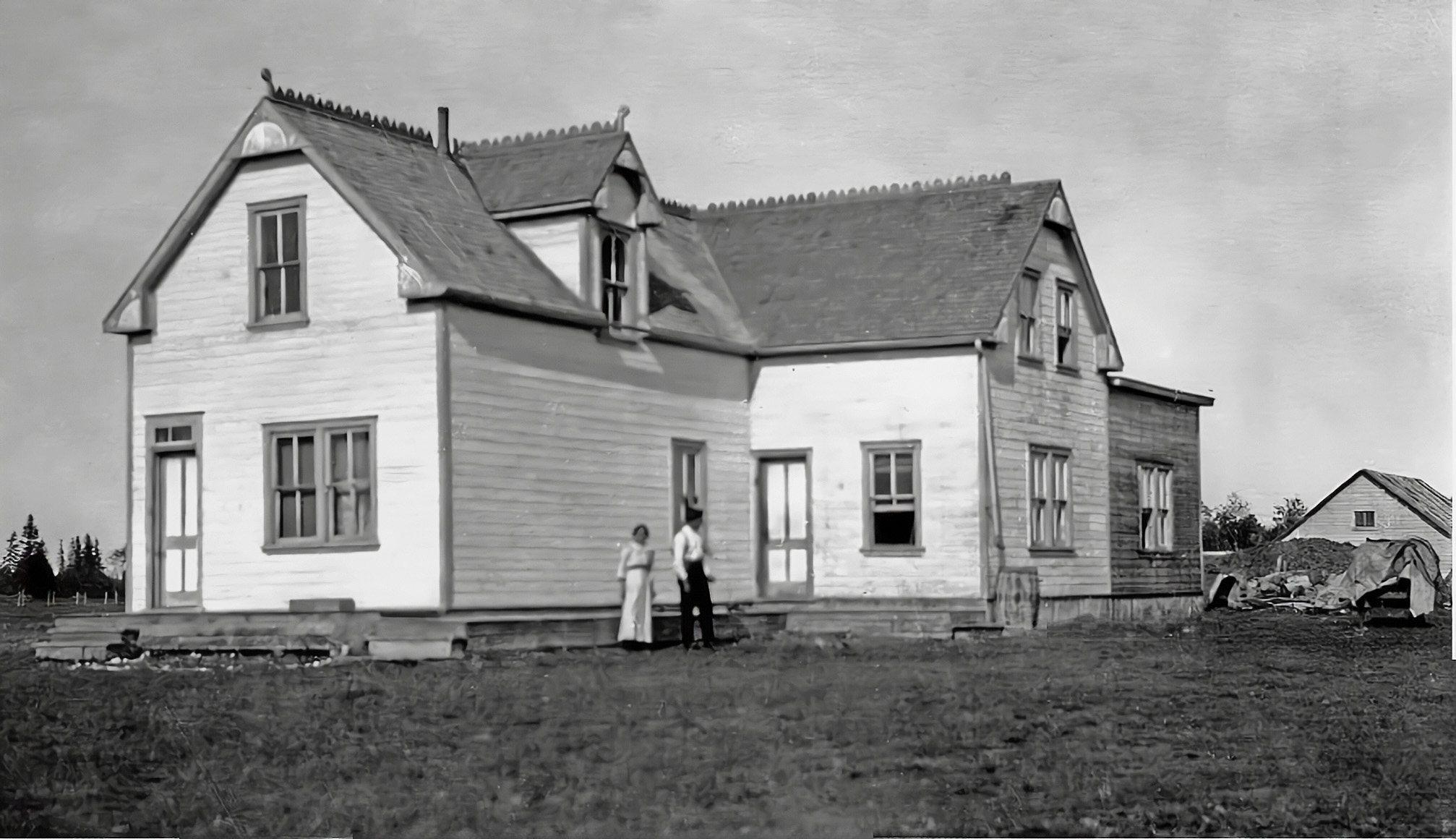 Engimýri as it appeared in 1910
Engimýri as it appeared in 1910With a long and eventful history as both a pioneer home and a ‘stopping place’ for countless travellers and freighters, this building was for decades a centre of hospitality, fellowship, and traditional Icelandic culture.
Typical in style of the two-storey frame homes built by the pioneers around and just after the turn of the last century, Engimýri House was constructed primarily of local building materials from the nearby sawmill at Icelandic River. Its interior features original beadboard wainscoting and panelling, and the exterior retains original decorative gable and eve motifs. Elaborate fretwork evident on the ridge-capping in early photos can be recreated. The pioneer carpenters of this structure, both formally trained in Iceland, were Trausti Vigfiisson. who later built most of the churches and schools in the area, and Jónas Jónasson of Lon, whose claim to fame was as printer of Framfari, published at Riverton from 1877-80.
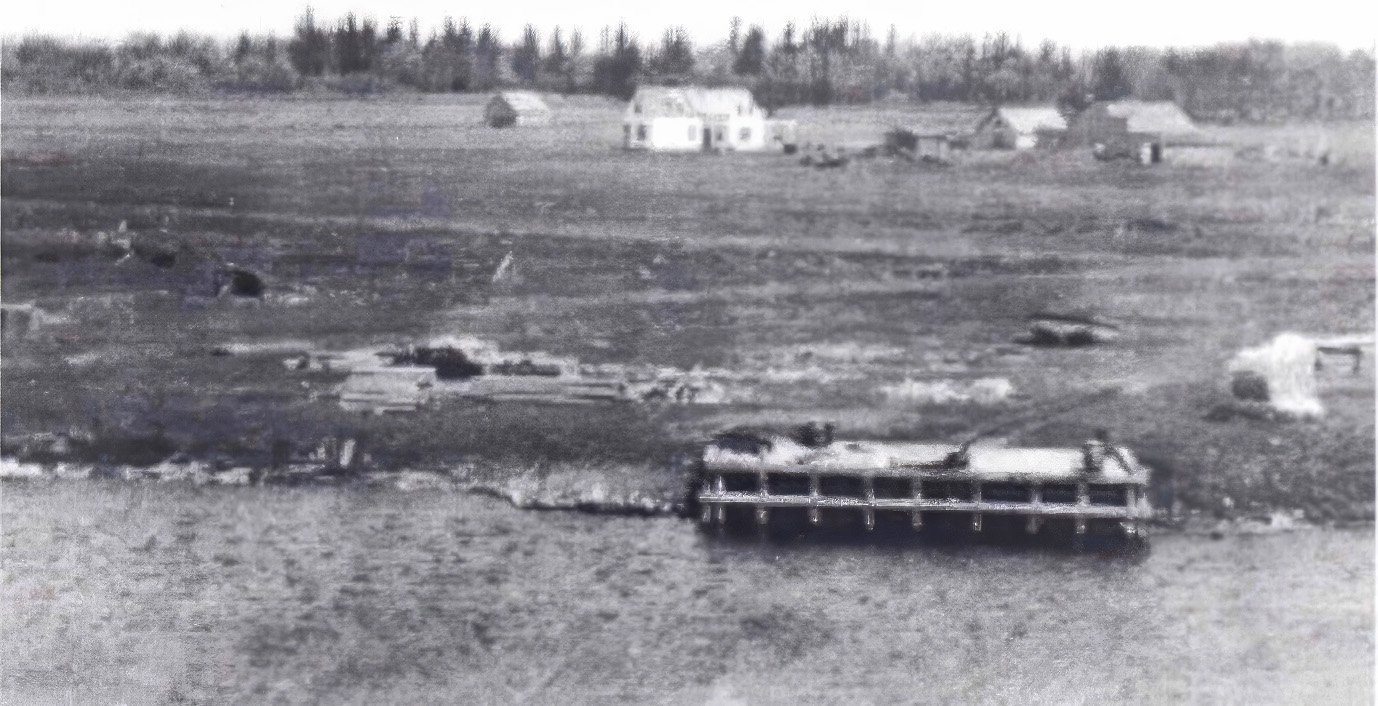 Engimýri from across the Icelandic River
Engimýri from across the Icelandic River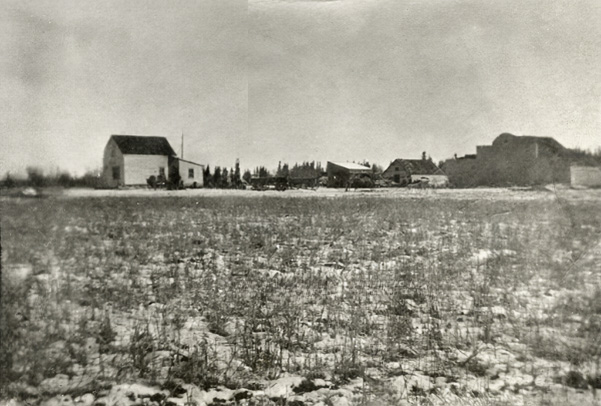 Engimýri in 1900
Engimýri in 1900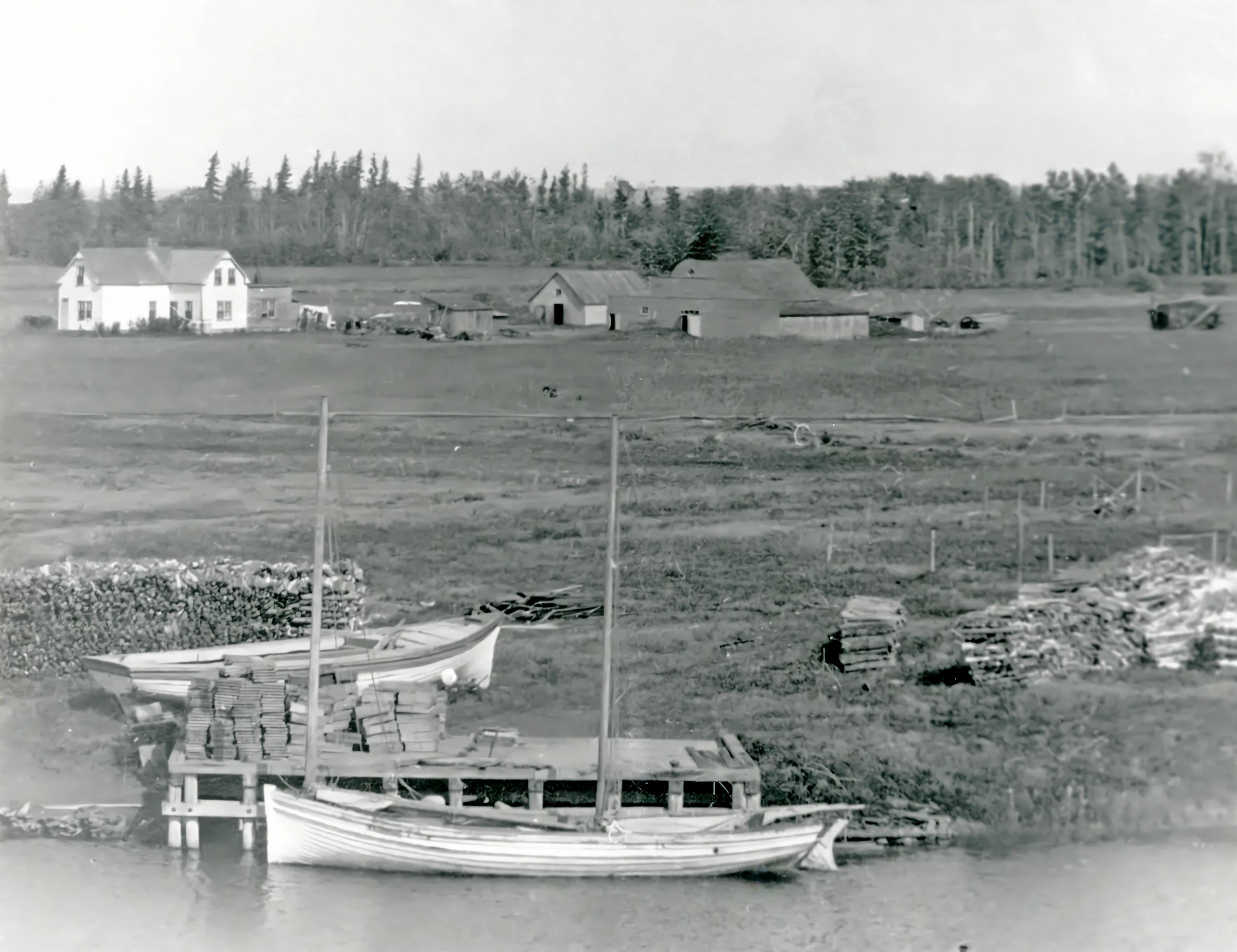 Another view of Engimýri from across the Icelandic River
Another view of Engimýri from across the Icelandic RiverA Stopping Place
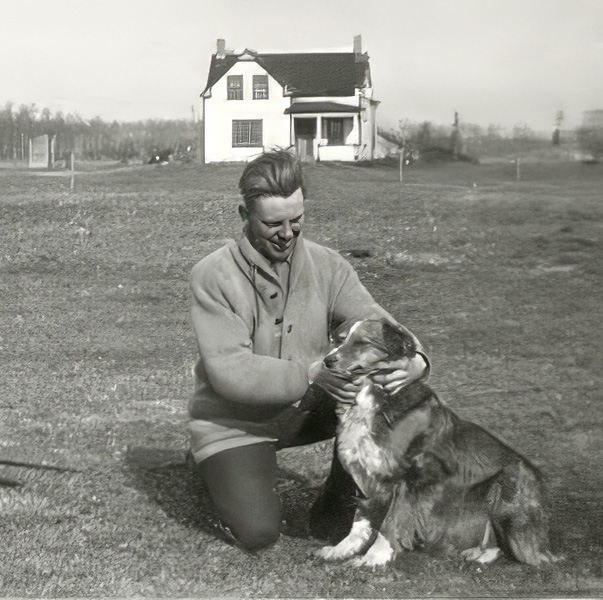 Beggi at Engimýri
Beggi at EngimýriAs the homestead of Engimýri was situated at the northern terminus of the Colonization Road (Icelanders' Road), which began at Boundary Creek and ran the length of New Iceland, the home became a “stopping place” shortly after settlement in 1877. Tomas Jónasson, the homesteader, had been raised in a home in Iceland that had served as a wayside inn, and hospitality to wayfarers was a deeply-rooted Icelandic tradition. In order to accommodate and feed the many visitors, an entire wing was added to the house prior to 1910. In its heyday, the house slept as many as 80 overnight guests of every background, from as far afield as Hudson’s Bay and Norway House. The nearby stables sheltered the teams and as many as 50 howling sleigh dogs were tied to every available post. Gudrun Jónasson. the mistress of the house, stayed up half the night baking and preparing food with the help of her daughters.
The family at Engimýri was musically gifted, so the home was frequently the site of music, singing, and dancing. Three sons, Jonni, Joi. and Beggi Jónasson, were talented violinists, and it is said that no-one could "trill’ a violin like Jonni. who composed several waltzes. Tommi played piano. Daughter Raenka played piano and organ, and Sibba played violin, guitar, and piano. Everyone sang and danced.
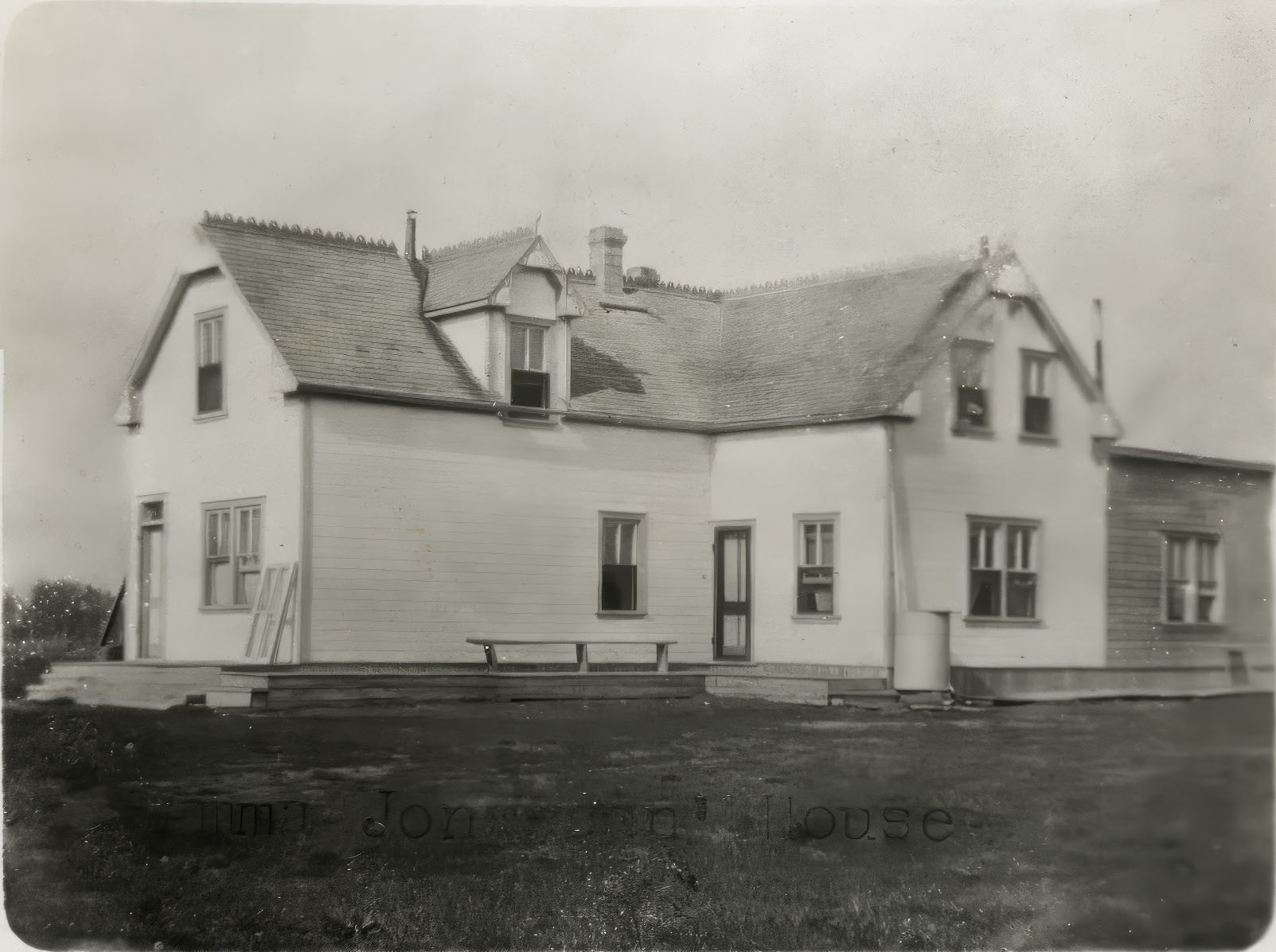 Engimýri in 1910
Engimýri in 1910Engimýri circa 1910…. The wing on the left, which was the house as it was built in 1900, provided enough room for the many wayfarers who used Engimýri as a “stopping place”. Situated at the northern terminus of the old “Colonization Road” (also called Íslendingabraut or Icelanders’ Road), and near the riverbank, the house served as an “inn” until the arrival of the railway at Icelandic River in 1914 - at which time a hotel was built west of the river - near the station. The west wing of the house at Engimýri was then cut off and moved to King Street to serve as a residence for Jón and Thórhildur Gíslason. It still stands there, though modified beyond recognition, and is owned by Kristin Gíslason. The remaining portion of the Engimyri house, built shortly after 1900, was refronted with the existing west gable visible today.
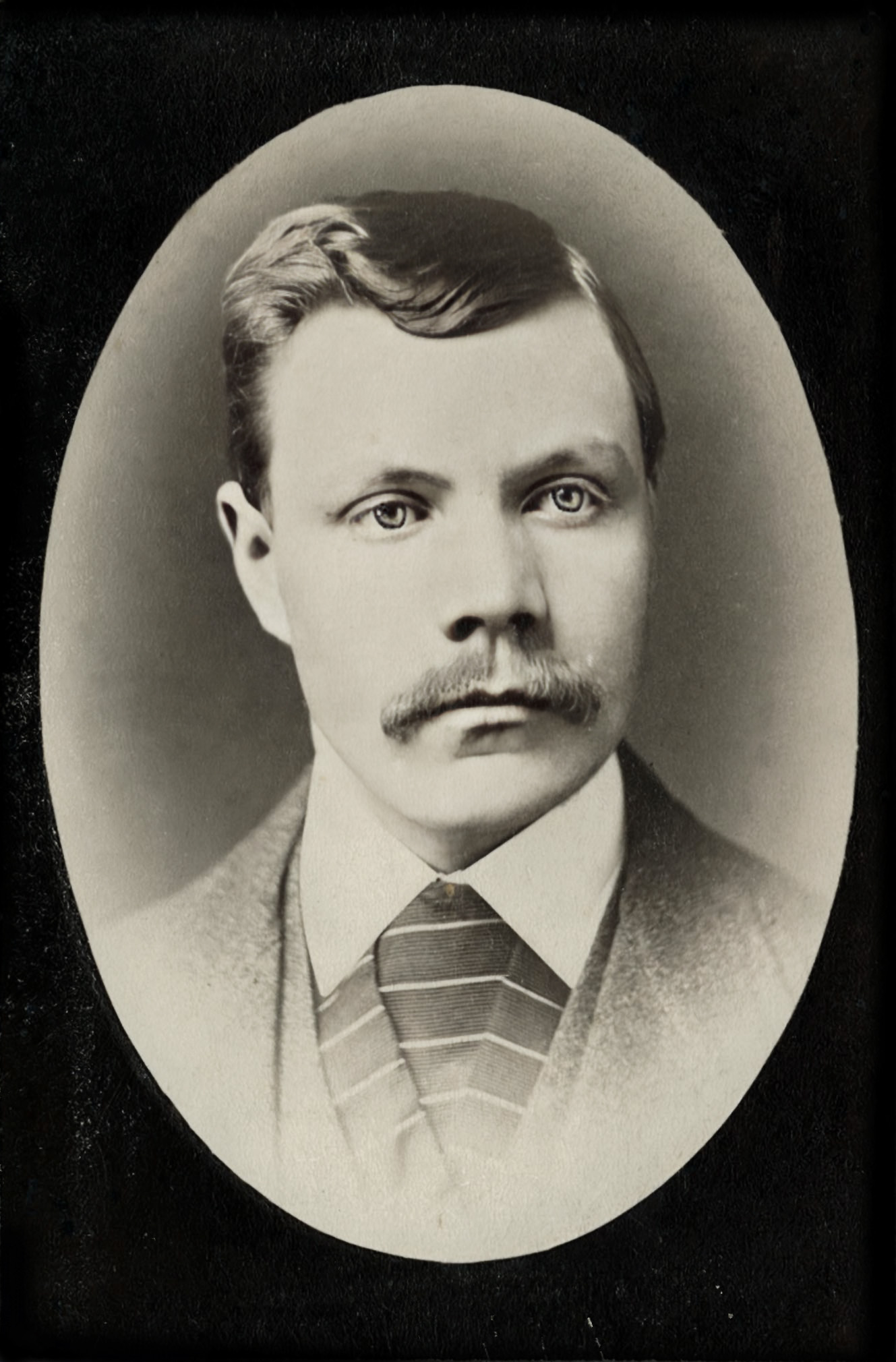
For some years, Engimýri was also home and headquarters of Sigtryggur Jónasson (1852- 1942), “Father of New Iceland” (brother to Tomas Jónasson, owner of Engimýri), who has recently been chosen for federal designation as a “person of national historic significance”. As former immigration official, editor of Framfari and Logberg, ship’s captain, sawmill and transport entrepreneur, homestead agent, and Member of the Manitoba Legislature, Sigtryggur spent several of his retirement years here, gathering material for a written history of the Icelandic people in Canada. He also edited the periodical Syrpa during his time here. The room at Engimyri that served as his office is still intact and will be known as 'Sigtryggs Stofa’ (Sigtryggur’s Parlour).
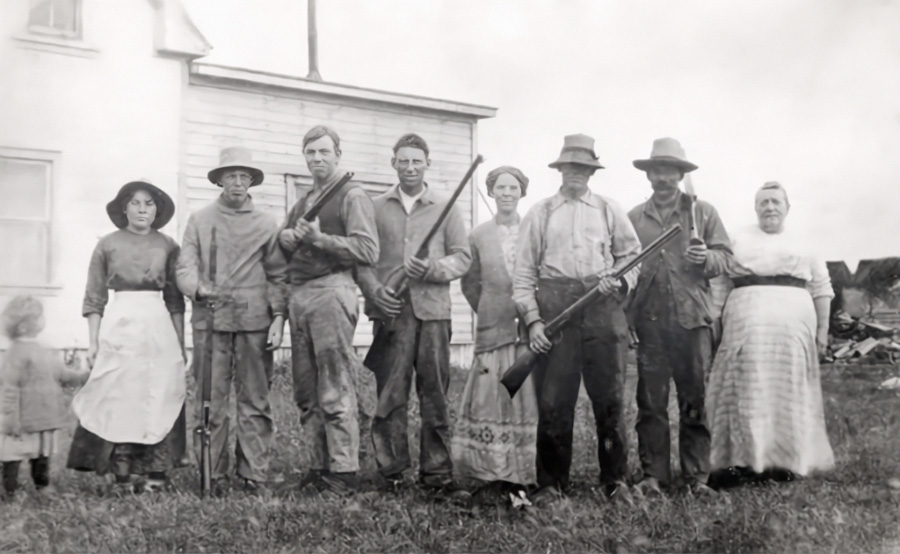 Engimýri Family - The Dog Hunters
Engimýri Family - The Dog HuntersMany other notables stayed as guests at Engimýri over the years. Poet and teacher Jon Runolfsson boarded here for some time, and many early clergymen, dignitaries, and notables stayed here during visits to Icelanidic River. In 1914 Admiral Byrd arrived and stayed while procuring his quota of sleigh dogs for his expedition to the South Pole, and on the occasion of his departure a farewell gathering was held at Engimýri.
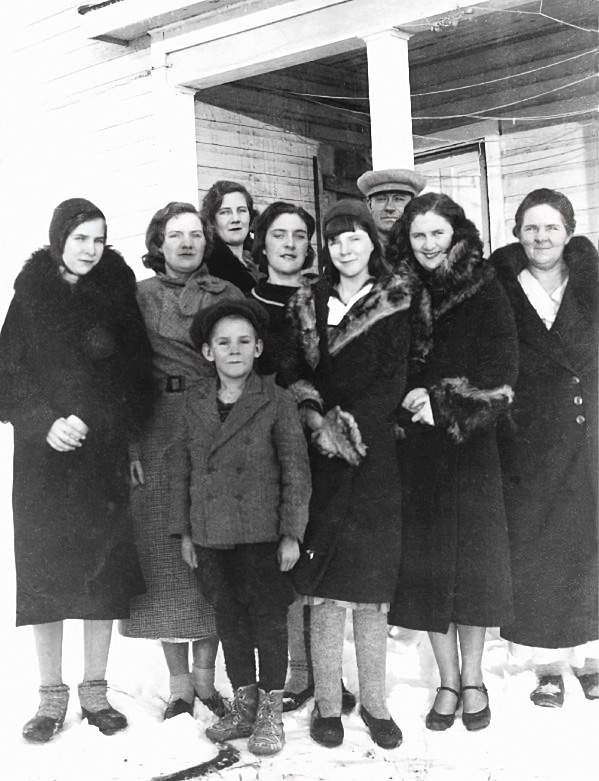 Engimýri Family
Engimýri Family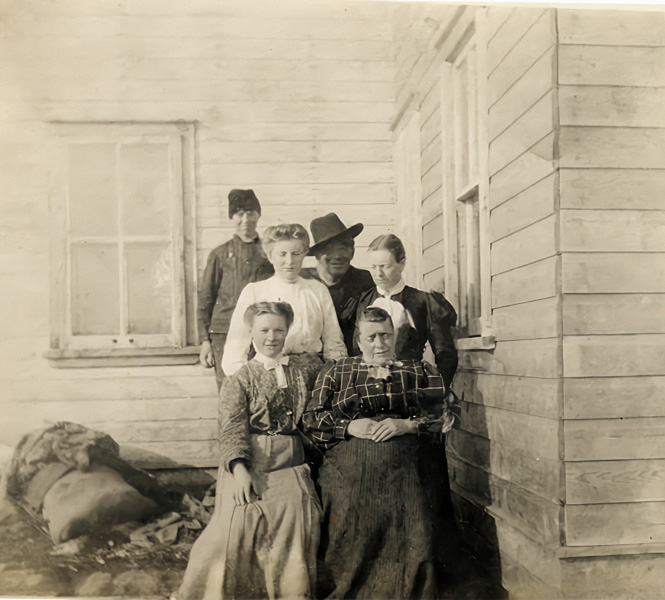 Engimýri Folk
Engimýri FolkEngimýri Historic Stopping Place Restoration
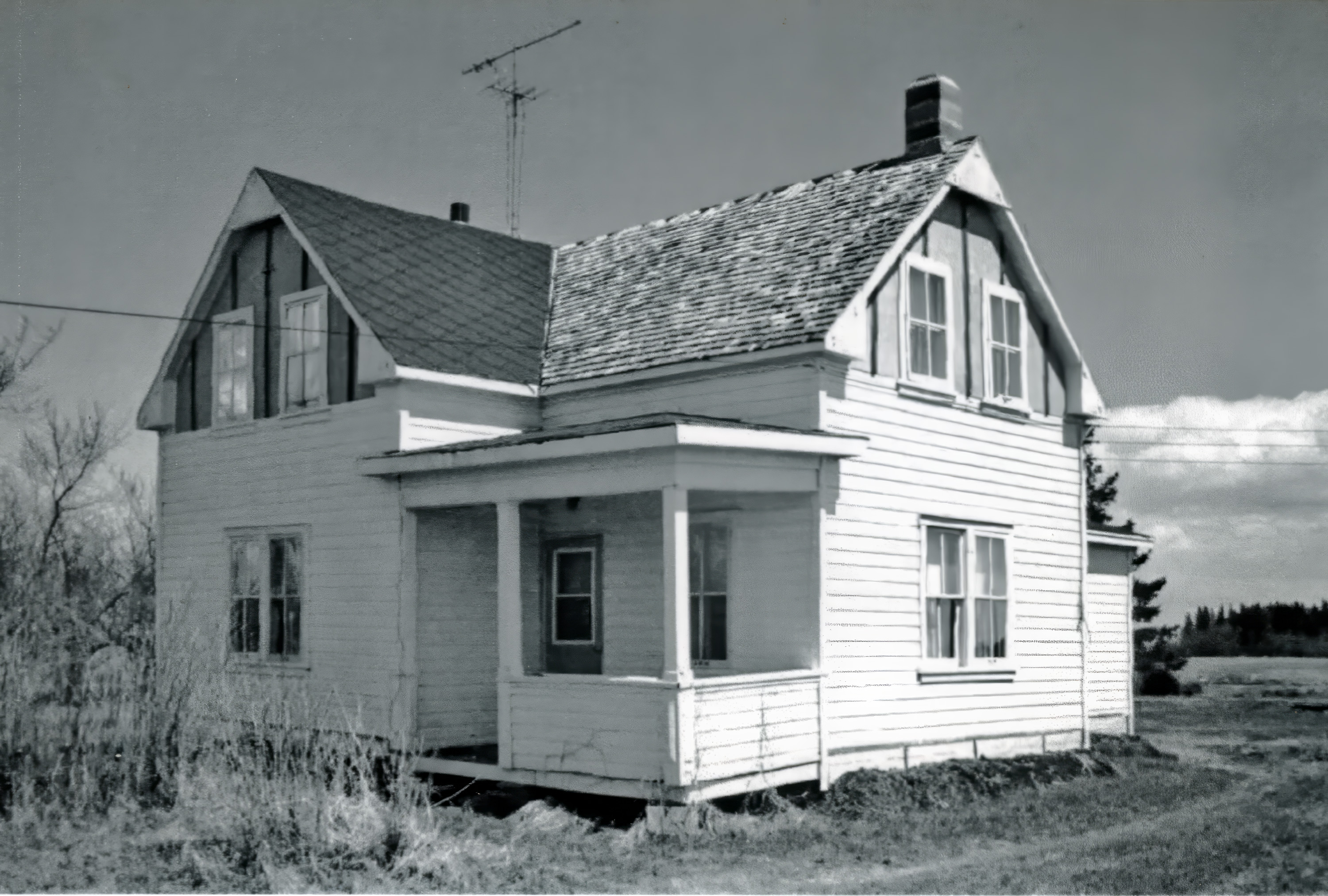 Engimýri House
Engimýri HouseThe historic house at Engimýri (Meadow Mire), now one of the oldest surviving residences in the Icelandic River area, was built in 1900 - making it more than 110 years old. The home of pioneers Tomas Agust Jónasson and Gudrun Egidia Johannesdóttir, who arrived in New Iceland in 1876, this homestead was named for Tomas’ birthplace in the Oxnadalur Valley of Northern Iceland. As this homestead was situated at the northern terminus of the original ‘Icelanders’ Road’ (Colonization Road), which connected Icelandic River with Sandy Bar, Gimli, and points further south, the home at Engimyri served as a ‘stopping place’ for travellers and a model of Icelandic hospitality - a tradition carried on from Tomas’ parents, whose home in Iceland had served as a wayside inn for many years. Subsequently occupied by son and grandson of the same name, Engimýri was designated a ‘centennial farm’ in 1977. The house is one of the few remaining structures built by pioneer carpenters Trausti Vigfusson and Jónas Jónasson of Loni.
Our Vision for Engimýri
The Icelandic River Heritage Sites vision is not only to preserve the pioneer home at Engimýri with images and objects from its history, but to make it once again a living and working centre of community and cultural activity.
- “Sigtryggs Stofa”, once used as an office by Sigtryggur Jonasson, will contain a genealogical reference library, artifact exhibit, and an interpretive display on the Father of New Iceland.
- Wall Space throughout the house will display archival photo images relating to the history of the house, its occupants, and the district.
- Dining Room and Parlour will serve as a traditional Icelandic meeting place, for hospitality, group & tour receptions, performances, and as a Board Room for IRHSI.
- On site are authentic early models of a hay mower, binder, and threshing machine, which we plan to restore and display.
The Engimýri Restoration Project
Before Restoration in 2010
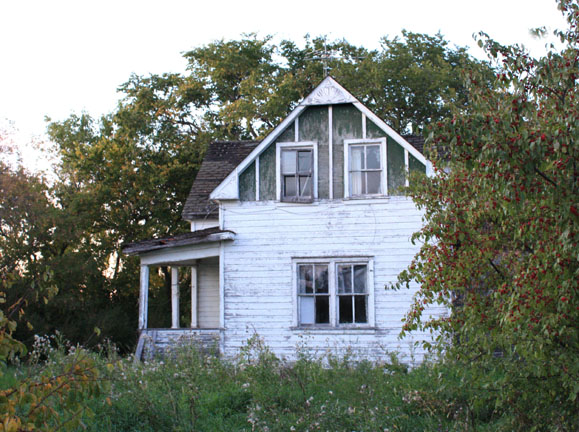 Engymýri was sadly in need of restoration
Engymýri was sadly in need of restorationTypical of the new frame structures that began replacing early log homes in New Iceland around the turn of the 19th century, the Engimýri house reflected the improved economic circumstances of those who could afford such homes. These new houses also displayed elements of style that were indications of both the skill levels of the the carpenters and the desire of the settlers to decorate their homes for the first time. Such ornamentation was often a modest version of Victorian "gingerbread" combined with Icelandic elements, as is evident on the Engimýri house in both the decoratively cut out "ridge boards" and ornate "gable heads" reminiscent of a ship's prow. The three facia corners of the west and south gables are also decorated with fairly elaborate woodwork in the form of "sunbursts" and clover leaves - still predominantly intact at the time of restoration, though delicate and in some cases in need of replacement parts.
 Beginning work on on the restoration Beginning work on on the restoration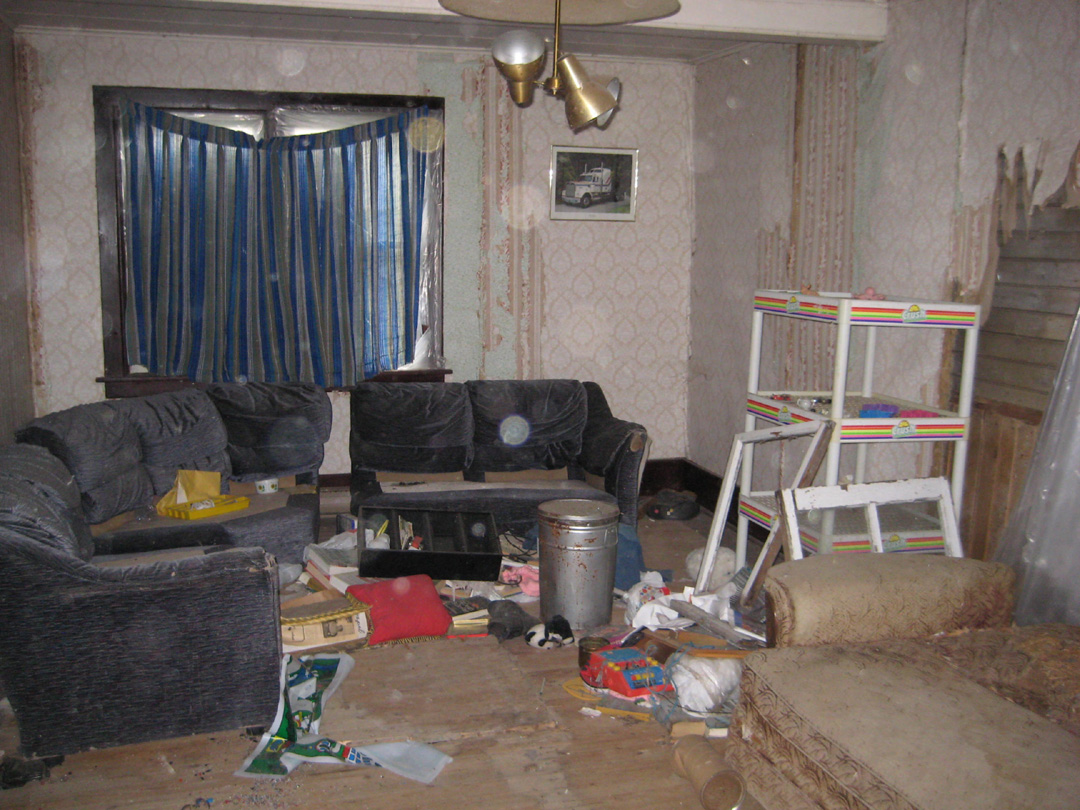 The Living Room of Engimýri needed much work The Living Room of Engimýri needed much work Original hutch in the Engimýri Kitchen Original hutch in the Engimýri Kitchen |
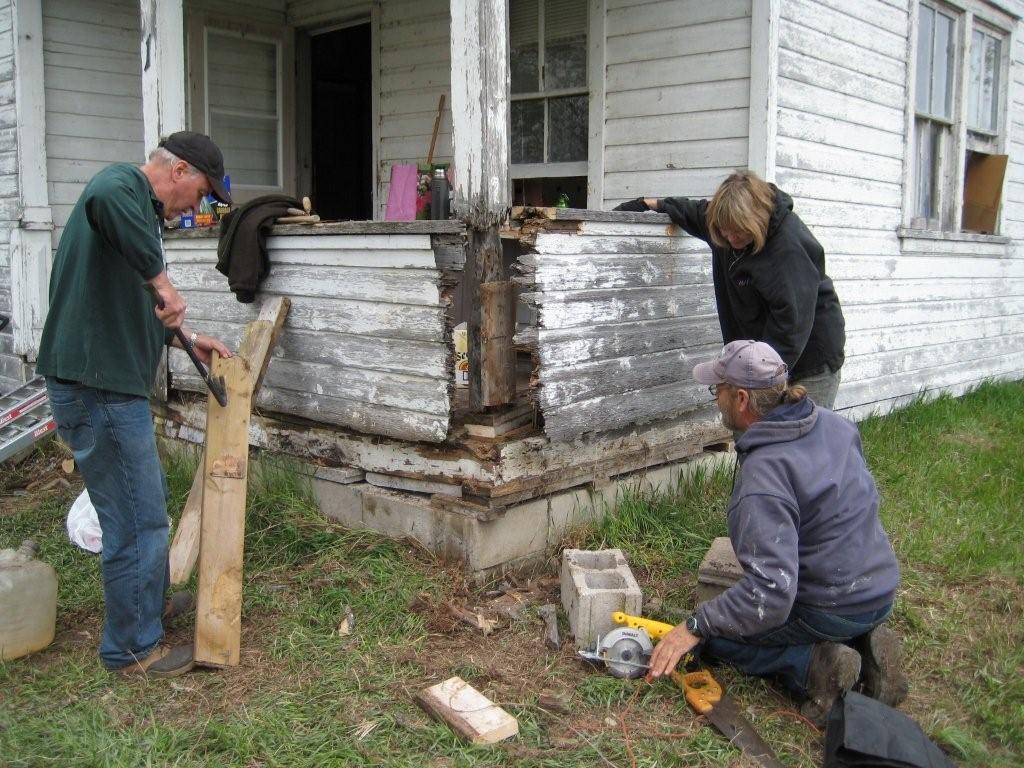 Severe water damage has happened over the years Severe water damage has happened over the years The upstairs and bedrooms of Engimýri The upstairs and bedrooms of Engimýri |
Restoration of the house at Engimýri by Icelandic River Heritage Sites began in the spring of 2011 with general clean-up, window repairs and reconstruction, and a refurbished cedar shingle roof. The majority of this work was done by volunteer labour. The roof work was cost shared by the Manitoba Government's Community Places program. Fundraising (mostly sales of Icelandic River Roast coffee beans) and donations made the first stages of restoration possible and pulled the house back from the brink of certain ruin due to water leakage. New temporary roofing was also installed on the badly leaking kitchen addition during the summer of 2011.
To deal with some serious structural and shell deterioration on the exterior and underside of the 112 year old house and the considerably younger porch and attached kitchen, Icelandic River Heritage Sites contracted with Task Force Construction of Riverton in the spring of 2012. Advanced decay to the porch (not original) and its hazardous condition made its removal necessary, and considerable work was needed to repair and replace some of the tongue and groove siding. Plywood coverings had also been added over the siding on the gables, and this had to be removed to restore the earlier look of the house. Temporary replacement steps and platforms were also built for both the front and rear doors, and in additional to dealing with deteriorated siding and trim, some structural timber was replaced. IRHS volunteers then scraped the siding to remove old paint and primed the exterior of the house during the hots weekends of July, and in late August they began applying the final coat of paint. The house committee selected a light yellow shade for the walls and off white for the trim, with dark green for the doors and grey-green for detailing on the gable ends, ridge boards, and gable heads. Benjamin Moore Paints/Portage Avenue Paints supplied the paint in conjunction with their heritage homes program, and Benjamin Moore's top of the line Aura paint is being used for the project.
Engimýri After Restoration
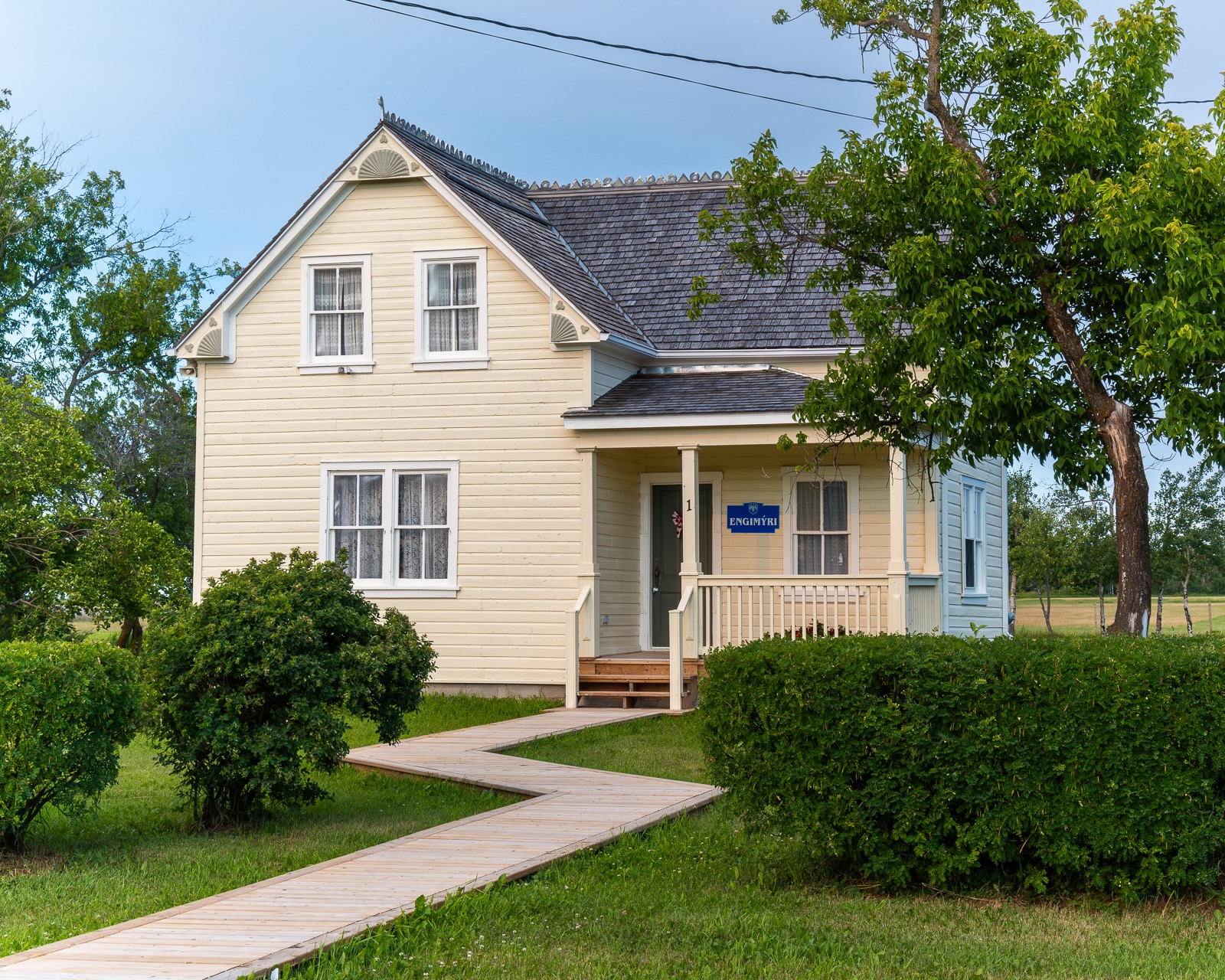
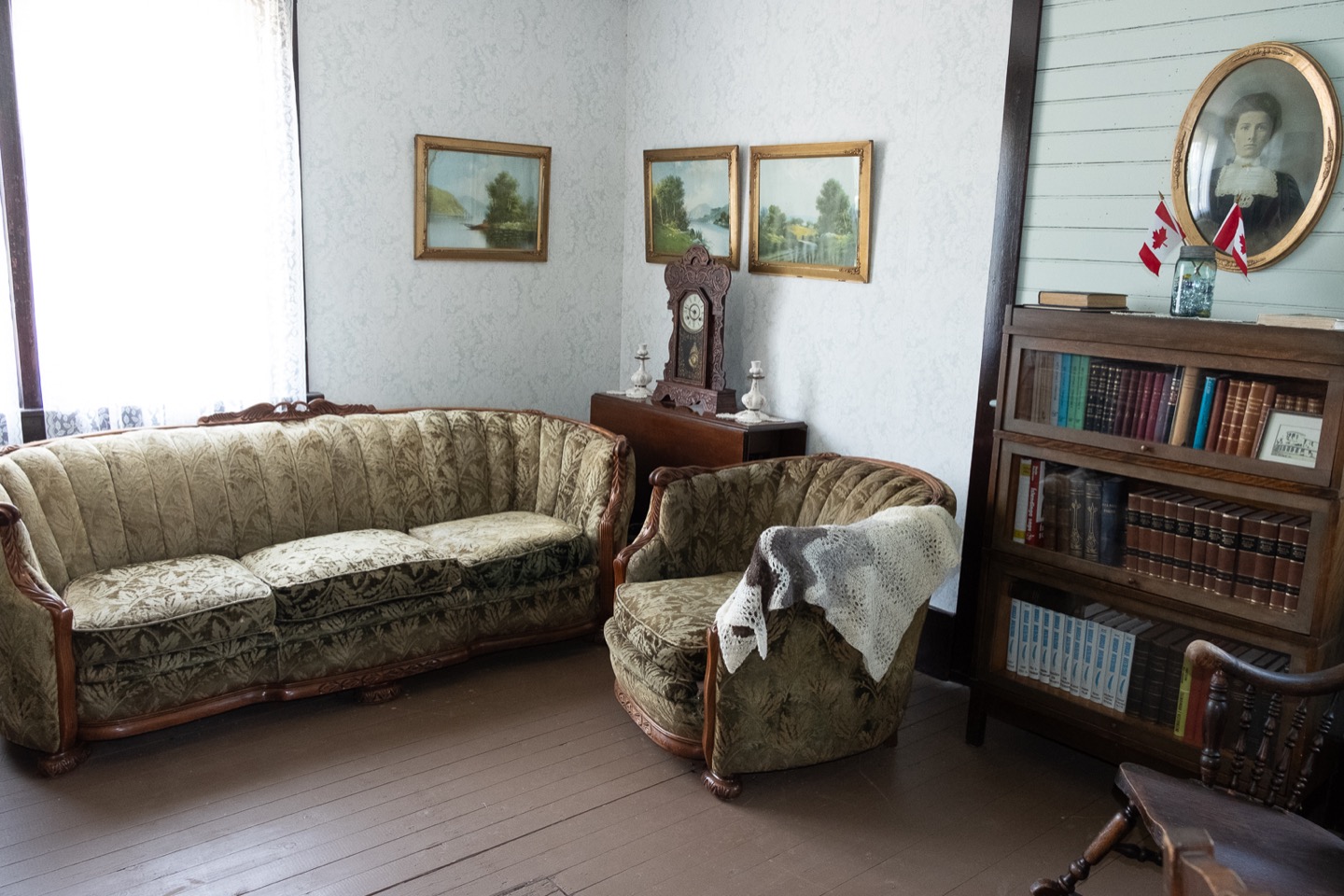 Front Parlour Engimýri Front Parlour Engimýri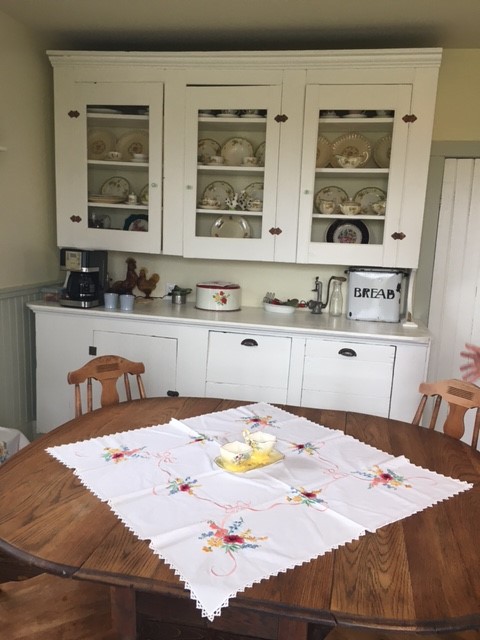 Kitchen hutch is restored at Engimýri Kitchen hutch is restored at Engimýri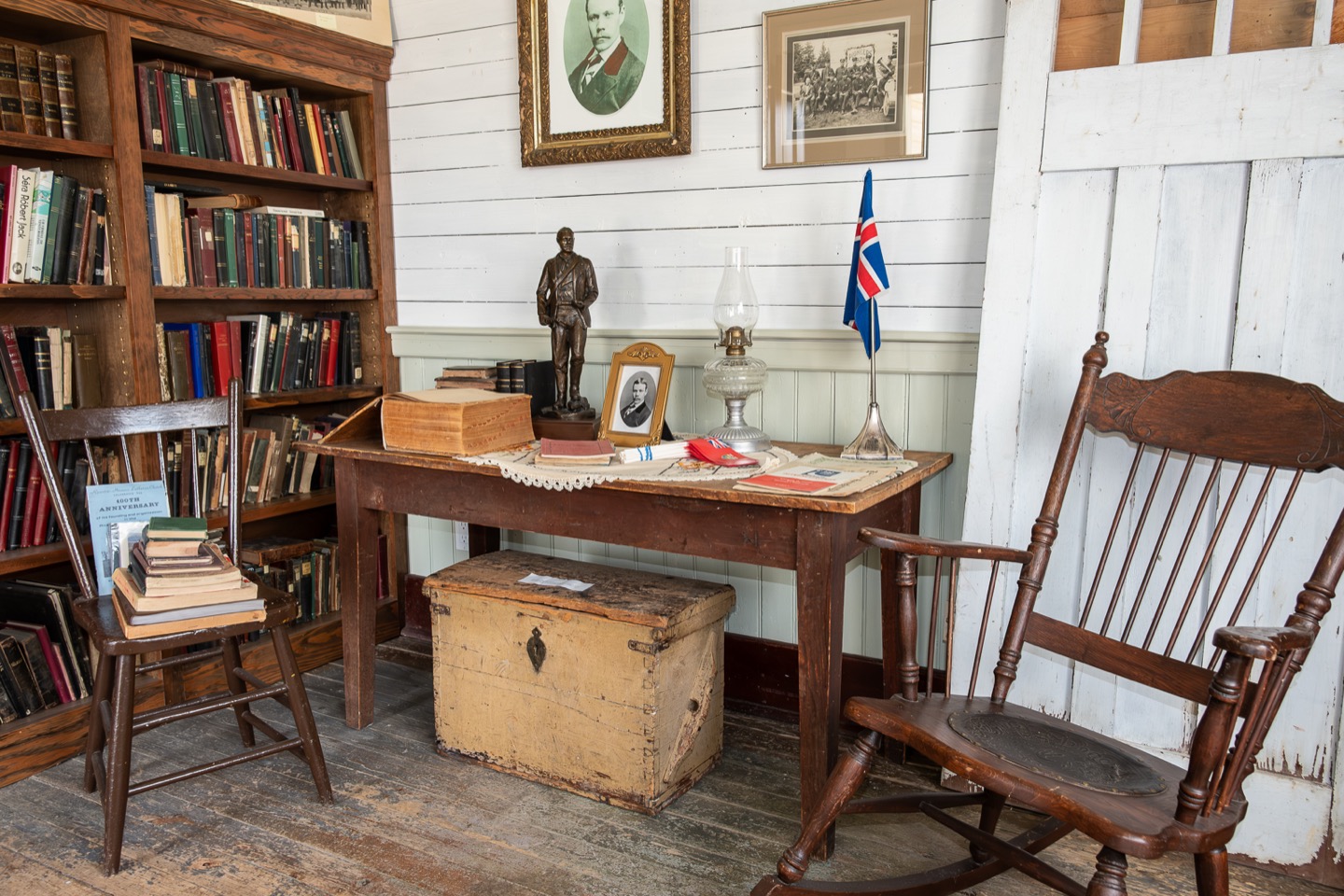 Sigtriggur's Study Engimýri Sigtriggur's Study Engimýri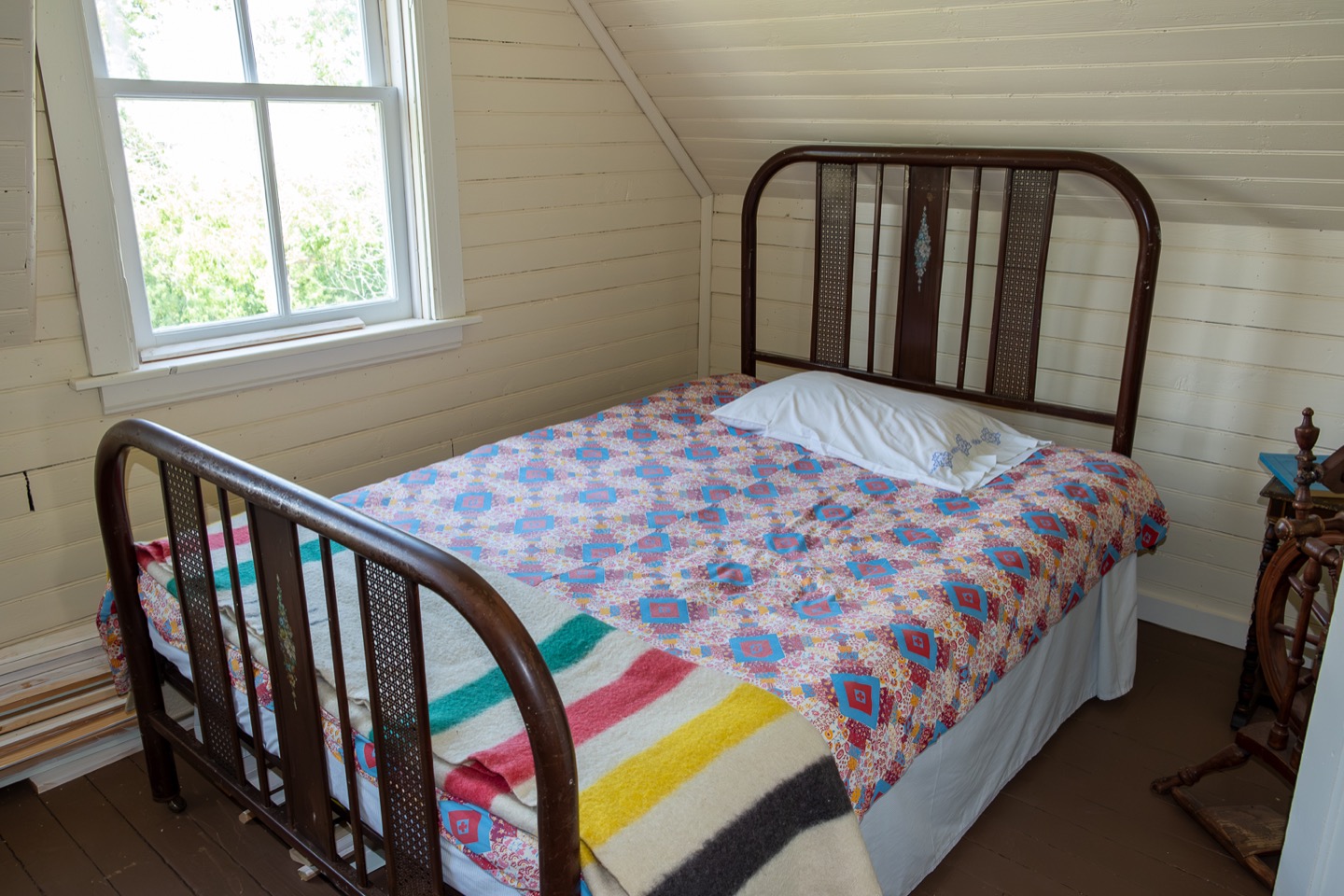 Gentlemen's Bedroom Engimýri Gentlemen's Bedroom Engimýri |
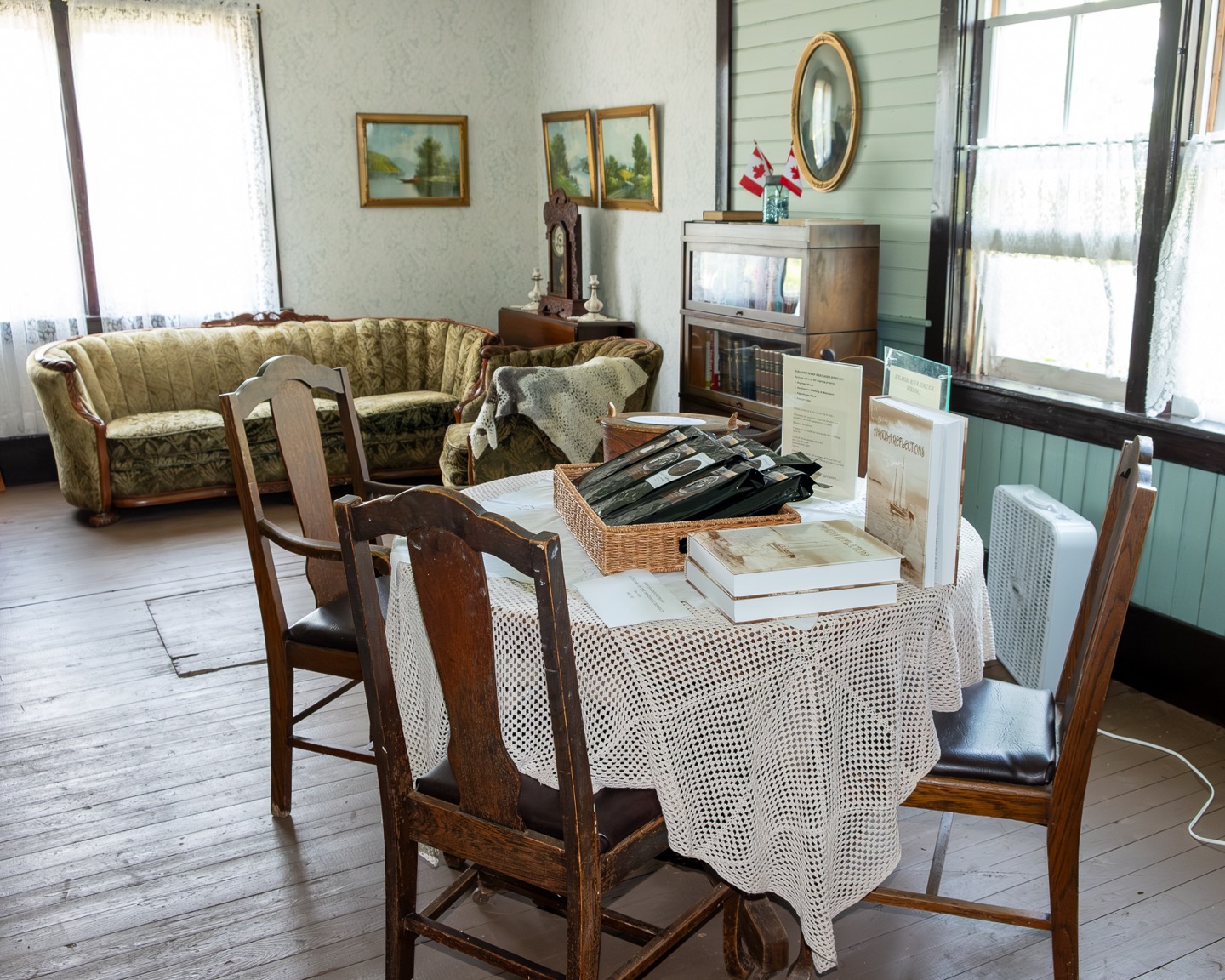 Dining Room in Engimýri Dining Room in Engimýri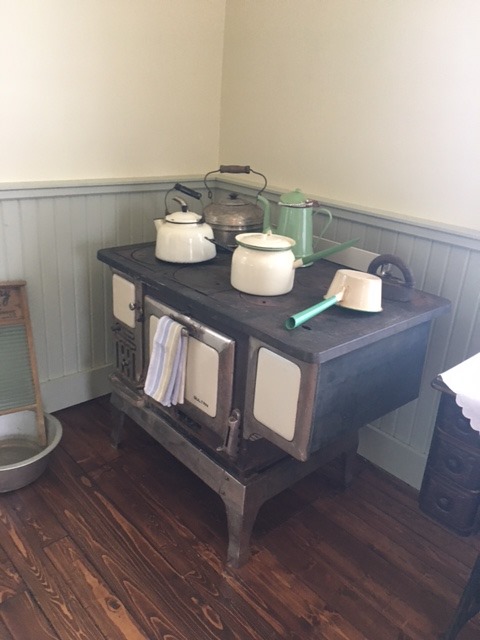 Kitchen stove at Engimýri Kitchen stove at Engimýri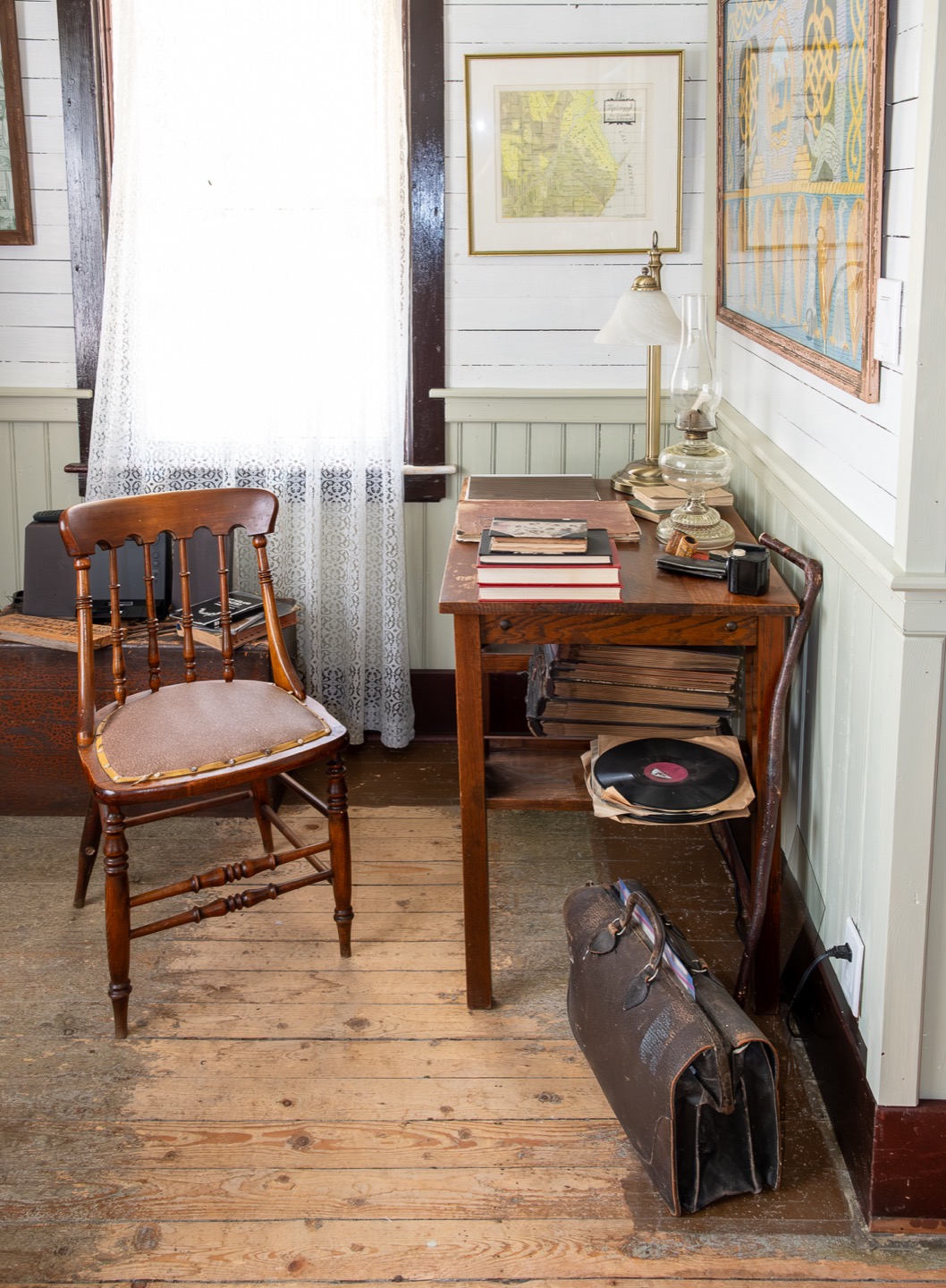 Sigtryggur's Desk Sigtryggur's Desk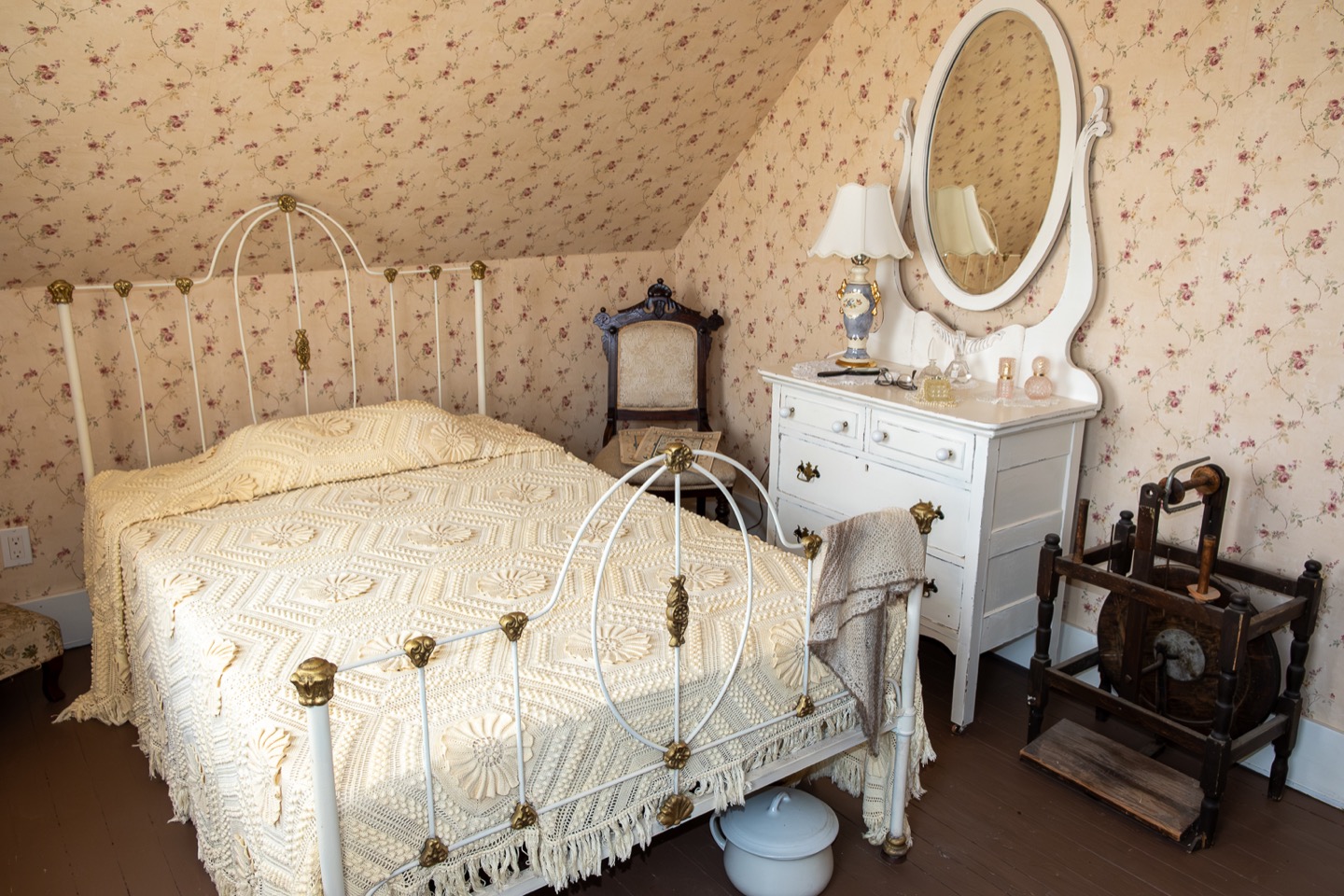 Main Bedroom Engimyýri Main Bedroom Engimyýri |
Countless hours of volunteer labour have been contributed by Icelandic River Heritage Sites members and friends who provide their own equipment at no cost, including the addition of a culvert for the Queen Street location, a new driveway just north of the house, as well as the time effort needed to remove debris from the yard and the equipment to do it. Support for the restoration of Engimýri has also been received in the form of donations of antique furniture, including some pieces original to the house.
In addition to donations and the sales of Icelandic River Roast coffee beans, IRHS has funded our restoration efforts through the hosting of cultural events in Riverton, including performances by choirs and a dance troupe from Iceland. Tour groups and individuals have also begun visiting Engimýri (by prior arrangement only), and two groups of Icelanders (50 total) who visited Engimýri in August of 2012 made an outstanding and very heart warming contribution in support of the restoration efforts.
